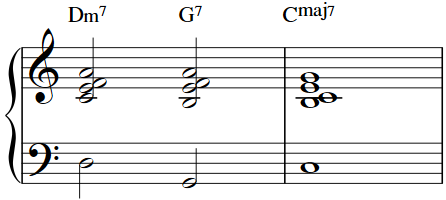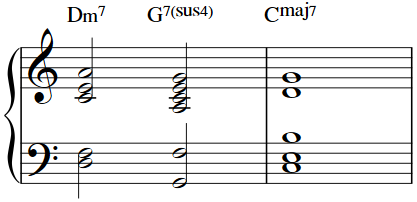Exciting Chord Progressions with the Dominant 7 Sus4 Chord

The dominant 7 sus4 chord (or suspended 4th) is oftentimes a bit of a confusing chord to piano students. In this article, we'll try to make sense of the dominant 7 sus4 chord by explaining how it's constructed, the theory behind the "suspended 4th," and some voicings that work well for pianists.
What is the Dominant 7 Sus4 Chord?
Let's start by comparing the regular "dominant 7 chord" to the "dominant 7 sus4 chord." The main difference is the chord tones of each chord. The chord tones of a dominant 7 chord are the root, 3rd, 5th, and 7th, whereas the chord tones of a dominant 7 sus4 chord are the root, 4th, 5th, and 7th, NOT the 3rd.
But why use the 4th as a chord tone? What are we suspending? The 4th creates what is referred to in music as a suspension (thus the "sus4"). We are suspending a resolution. That is the magic of the dominant 7 sus4 chord - it creates a sound in which the listeners are expecting to hear the suspended 4th scale degree resolve to the 3rd (in the example below, the 'F' resolves to the 'E').
Dominant 7 Sus4 Chord Voicings at the Piano
Learning how to voice (or spell) these dominant 7 sus4 chords is an important skill for pianists. It's important to know the upper extensions which are available to the dominant 7 sus4 chord - the 9th and 13th. The 3rd should not be used with the dominant 7 sus4 chord because it creates an inherent conflict and dissonance with the 4th. We're going to look at a couple different ways to spell the dominant 7 sus4 chord.
Dominant 7 Sus4 Chord Rootless Voicings
Consider the following ii-V-I progression in the key of 'C' using 4-way close position rootless voicings:
These are called 4-way close-position rootless voicings because each chord consists of 4 notes (4-way) within an octave range (close-position) and do not contain the root of the chord (the bass clef is shown in order to indicate the root of the chord, which a bass player would likely play). But what if we wanted to play Dm7 to G7sus4 to Cmaj7, or Dm7 to G7sus4 to G7 to Cmaj7? Consider this:
Notice that the G7sus4 voicing is the same as the Dm7 voicing. All that was changed was the root played under the chord. This is because the notes of the Dm7 chord also work as chord tones and extensions for the dominant 7 sus4 chord. The C, E, F, and A of the Dm7 chord (the 7th, 9th, 3rd, and 5th) also represent the 4th, 13th, 7th, and 9th of the G7sus4 chord.
Two-Handed Voicing for Dominant 7sus4 Chord
Now let's create a two-handed voicing for the G7sus4 chord. We'll use a chord shell in the left hand, such as root and 7th. In the right hand, we're going to use a voicing that consists of the 9th, 4th, 13th, and root (A, C, E, and G). These notes, played by the right hand, can also be thought of as a minor 7th chord that is built a whole-step above the root of the chord (in other words, an Am7 chord play over the G7 shell of the left hand).
Play through various dominant7 sus4 chords to get that sound in your ear and become better at recognizing its use in various songs.




